The Air Transportation System as a Subsystem of Modern Communication Space: Analysis Based on Transfer Entropy Graphs
Abstract
1. Introduction
2. Research Methodology
2.1. Problem Formulation
2.2. Procedure for Constructing an Entropy Transfer Graph
2.3. The Method of Analyzing the Communication Properties of Air Transportation
3. Case Studies
3.1. Regional Transportation
3.2. Analysis of the Communication Space of the Center and Regions
3.3. Air Transportation Between World Regions and Communication Space
3.4. TE Graph Max Flows Analysis
4. Conclusions
Author Contributions
Funding
Institutional Review Board Statement
Informed Consent Statement
Data Availability Statement
Conflicts of Interest
References
- Luhmann, N. Social Systems; Stanford University Press: Stanford, UK, 1995. [Google Scholar]
- Borch, C. Niklas Luhmann: In Defence of Modernity; Routledge: Milton Park, UK, 2011. [Google Scholar]
- Castells, M. The Information Age: Economy, Society and Culture; Wiley-Blackwell: Malden, MA, USA, 2000. [Google Scholar]
- Fortner, R.S. International Communication: History, Conflict, and Control of the Global Metropolis, 1st ed.; Cengage Learning: Boston, MA, USA, 1992. [Google Scholar]
- Thussu, D.K. International Communication: Continuity and Change, 3rd ed.; Bloomsbury Academic: London, UK, 2018. [Google Scholar]
- Stevenson, R.L. Defining International Communication as a Field. J. Mass Commun. Q. 1992, 69, 543–553. [Google Scholar] [CrossRef]
- Semati, M. (Ed.) New Frontiers in International Communication Theory; Rowman & Littlefield: Lanham, MD, USA, 2004. [Google Scholar]
- Khanna, P. Connectography: Mapping the Future of Global Civilization; Random House: New York, NY, USA, 2016. [Google Scholar]
- Bowen, J.; Rodrigue, J.-P. The Geography of Transport Systems, 6th ed.; Routledge: New York, NY, USA, 2024. [Google Scholar]
- Graham, B. Geography and Air Transport; Wiley: Hoboken, NJ, USA, 1995. [Google Scholar]
- Faizullin, F.S.; Valeev, S.S.; Kondratyeva, N.V. Analysis of Regional Air Transportation System as Subsystem of Communication Space. In Proceedings of the International Conference Communication Strategies of Information Society (CSIS 2018), St. Petersburg, Russia, 26–27 October 2018; Atlantis Press: Amsterdam, The Netherlands, 2019; pp. 274–278. [Google Scholar] [CrossRef]
- Adey, P.; Budd, L.; Hubbard, P. Flying Lessons: Exploring the Social and Cultural Geographies of Global Air Travel. Prog. Hum. Geogr. 2007, 31, 773–791. [Google Scholar] [CrossRef]
- Live Air Traffic. Available online: www.flightradar24.com (accessed on 2 October 2024).
- Federal Aviation Administration. Available online: https://www.faa.gov/ (accessed on 2 October 2024).
- Valeev, S.; Kondratyeva, N. Design of Nonlinear Control of Gas Turbine Engine Based on Constant Eigenvectors. Machines 2021, 9, 49. [Google Scholar] [CrossRef]
- Valeev, S.; Kondratyeva, N. Life Test Optimization for Gas Turbine Engine Based on Life Cycle Information Support and Modeling. Energies 2022, 15, 6874. [Google Scholar] [CrossRef]
- Bowen, J. Low-Cost Carriers in Emerging Countries, 1st ed.; Elsevier: Amsterdam, The Netherlands, 2019. [Google Scholar]
- O’Connell, J.F.; Williams, G. Air Transport in the 21st Century. Key Strategic Developments; Routledge: Milton Park, UK, 2011. [Google Scholar]
- Valeev, S.S.; Kondratyeva, N.V. Aviation industry stochastic model based on big data concept. Uchenye Zap. Kazan. Univ. Seriya Fiz. Mat. Nauk. 2018, 160, 392–398. [Google Scholar]
- Valeev, S.S.; Kondratyeva, N.V. Large scale system management based on Markov decision process and big data concept. In Proceedings of the 2016 IEEE 10th International Conference on Application of Information and Communication Technologies (AICT), Baku, Azerbaijan, 12–14 October 2016; pp. 6–9. [Google Scholar]
- Wang, Y.; Zhan, J.; Xu, X.; Li, L.; Chen, P.; Hansen, M. Measuring the resilience of an airport network. Chin. J. Aernaut. 2019, 32, 2694–2705. [Google Scholar] [CrossRef]
- Shi, Z.; Zhang, H.; Li, Y.; Zhou, J. Air Traffic Sector Network: Motif Identification and Resilience Evaluation Based on Subgraphs. Sustainability 2023, 15, 13423. [Google Scholar] [CrossRef]
- Cong, W.; Hu, M.; Dong, B.; Wang, Y.; Feng, C. Empirical analysis of airport network and critical airports. Chin. J. Aeronaut. 2016, 29, 512–519. [Google Scholar] [CrossRef]
- Yang, H.; Le, M.; Wang, D. Airline Network Structure: Motifs and Airports’ Role in Cliques. Sustainability 2021, 13, 9573. [Google Scholar] [CrossRef]
- Zanin, M.; Lillo, F. Modelling the air transport with complex networks: A short review. Eur. Phys. J. Spec. Top. 2013, 215, 5–21. [Google Scholar] [CrossRef]
- Kurant, M.; Thiran, P. Extraction and analysis of traffic and topologies of transportation networks. Phys. Rev. E. 2006, 74, 036114. [Google Scholar] [CrossRef] [PubMed]
- Schreiber, T. Measuring Information Transfer. Phys. Rev. Lett. 2000, 85, 461–464. [Google Scholar] [CrossRef] [PubMed]
- Zavala-Díaz, J.C.; Pérez-Ortega, J.; Almanza-Ortega, N.N.; Pazos-Rangel, R.; Rodríguez-Lelís, J.M. Influence of Transfer Entropy in the Short-Term Prediction of Financial Time Series Using an ∊-Machine. Entropy 2022, 24, 1049. [Google Scholar] [CrossRef] [PubMed]
- Jizba, P.; Lavička, H.; Tabachová, Z. Causal Inference in Time Series in Terms of Rényi Transfer Entropy. Entropy 2022, 24, 855. [Google Scholar] [CrossRef] [PubMed]
- Assaad, C.K.; Devijver, E.; Gaussier, E. Entropy-Based Discovery of Summary Causal Graphs in Time Series. Entropy 2022, 24, 1156. [Google Scholar] [CrossRef] [PubMed]
- Zhang, X.; Hu, W.; Yang, F. Detection of Cause-Effect Relations Based on Information Granulation and Transfer Entropy. Entropy 2022, 24, 212. [Google Scholar] [CrossRef] [PubMed]
- Struhár, J.; Rapant, P. Spatiotemporal Visualisation of PS InSAR Generated Space–Time Series Describing Large Areal Land Deformations Using Diagram Map with Spiral Graph. Remote Sens. 2022, 14, 2184. [Google Scholar] [CrossRef]
- UK Airport Data. Available online: https://www.caa.co.uk/data-and-analysis/uk-aviation-market/airports/uk-airport-data/ (accessed on 2 October 2024).
- Federal State Statistics Service. Available online: https://eng.rosstat.gov.ru (accessed on 2 October 2024).
- ICAO Statistical Regions. Available online: https://unitingaviation.com/amp/news/economic-development/the-air-transport-monthly-monitor-for-february-2021/ (accessed on 2 October 2024).
- A Network Map of the World’s Air Traffic Connections. Available online: https://www.visualcapitalist.com/air-traffic-network-map/ (accessed on 2 October 2024).
- The World Bank Group. Available online: https://data.worldbank.org/indicator/IS.AIR.PSGR (accessed on 2 October 2024).
- Cederbaum, I. On the optimal operation of communication nets. J. Frankl. Inst. 1962, 274, 130–141. [Google Scholar] [CrossRef]
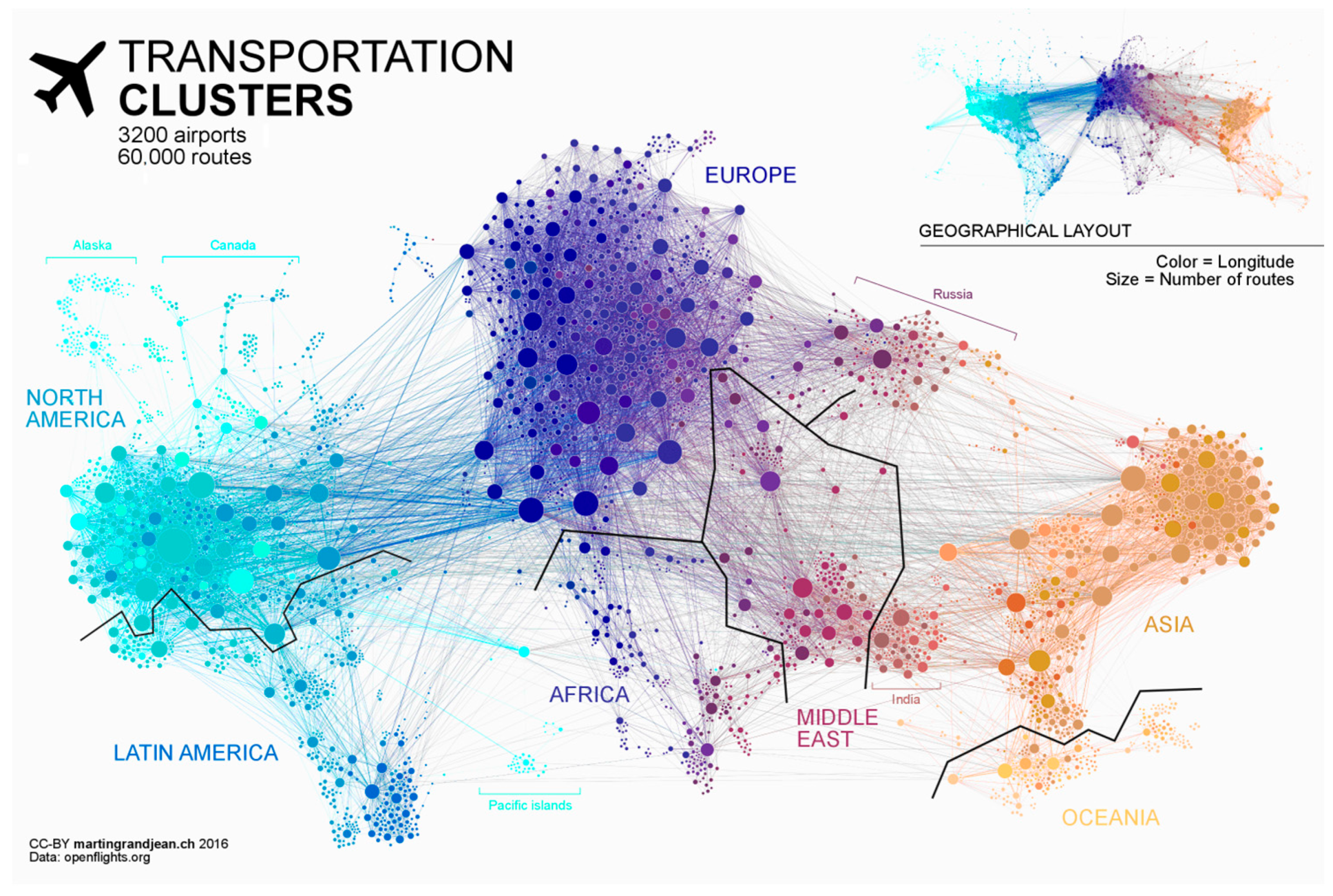
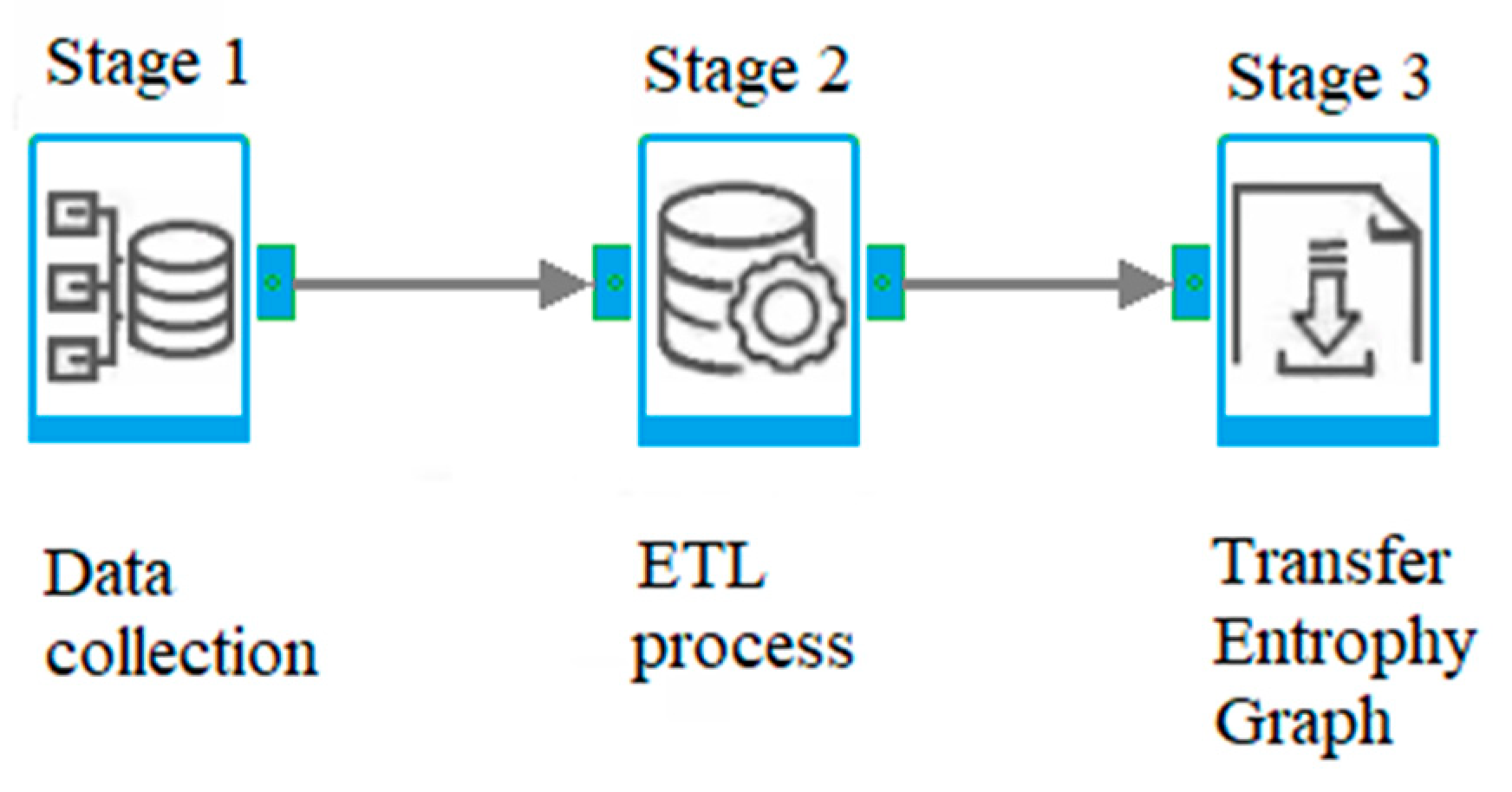

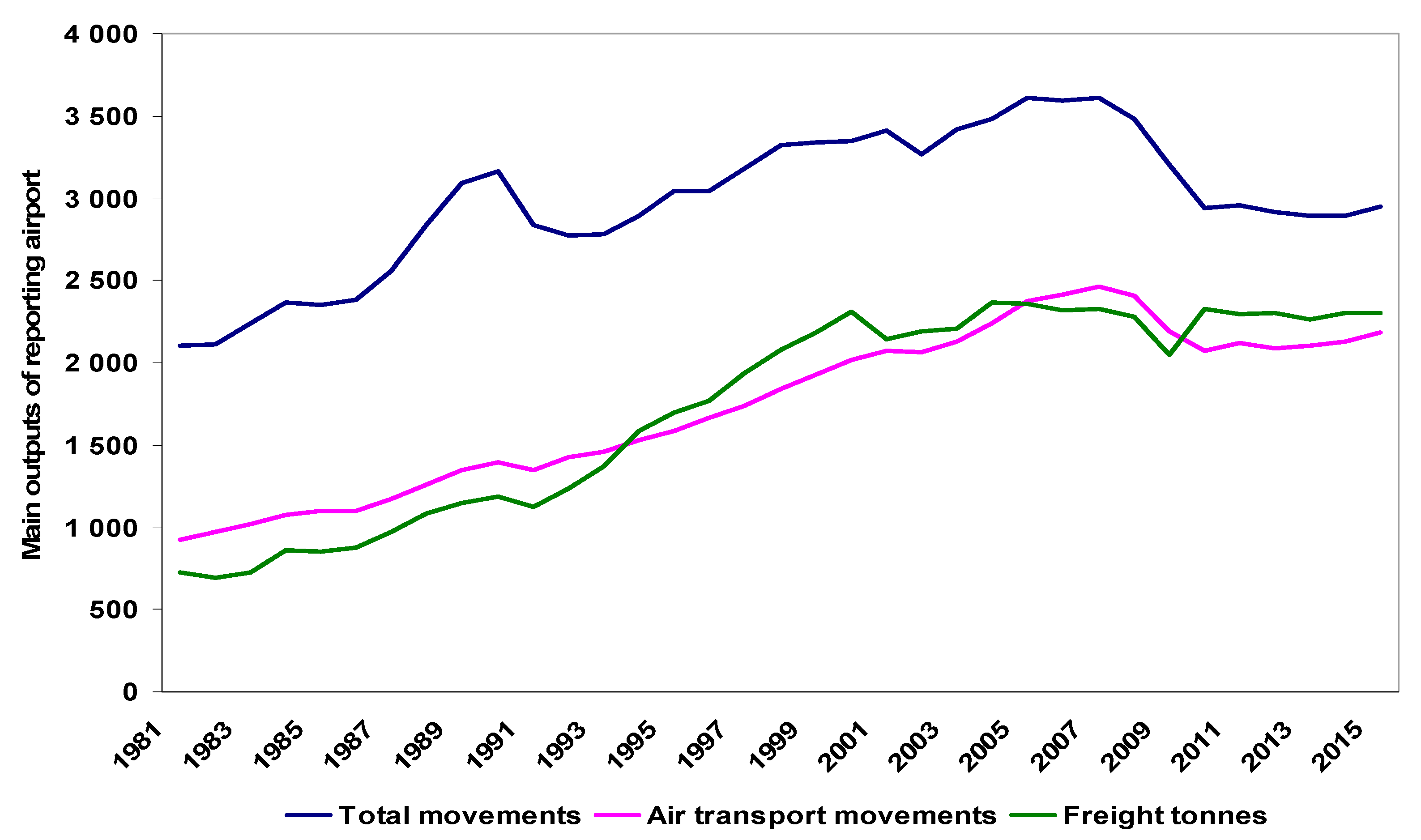
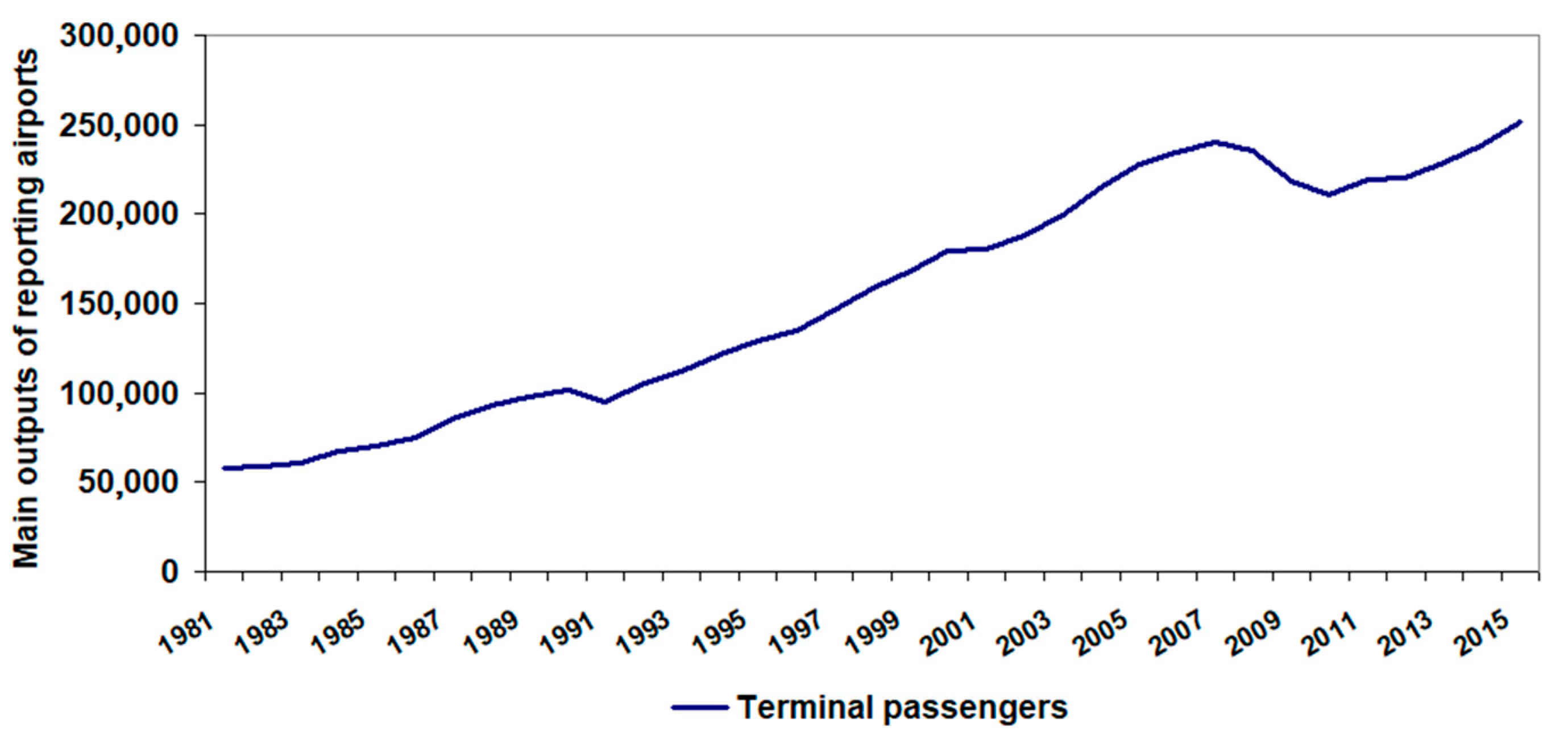

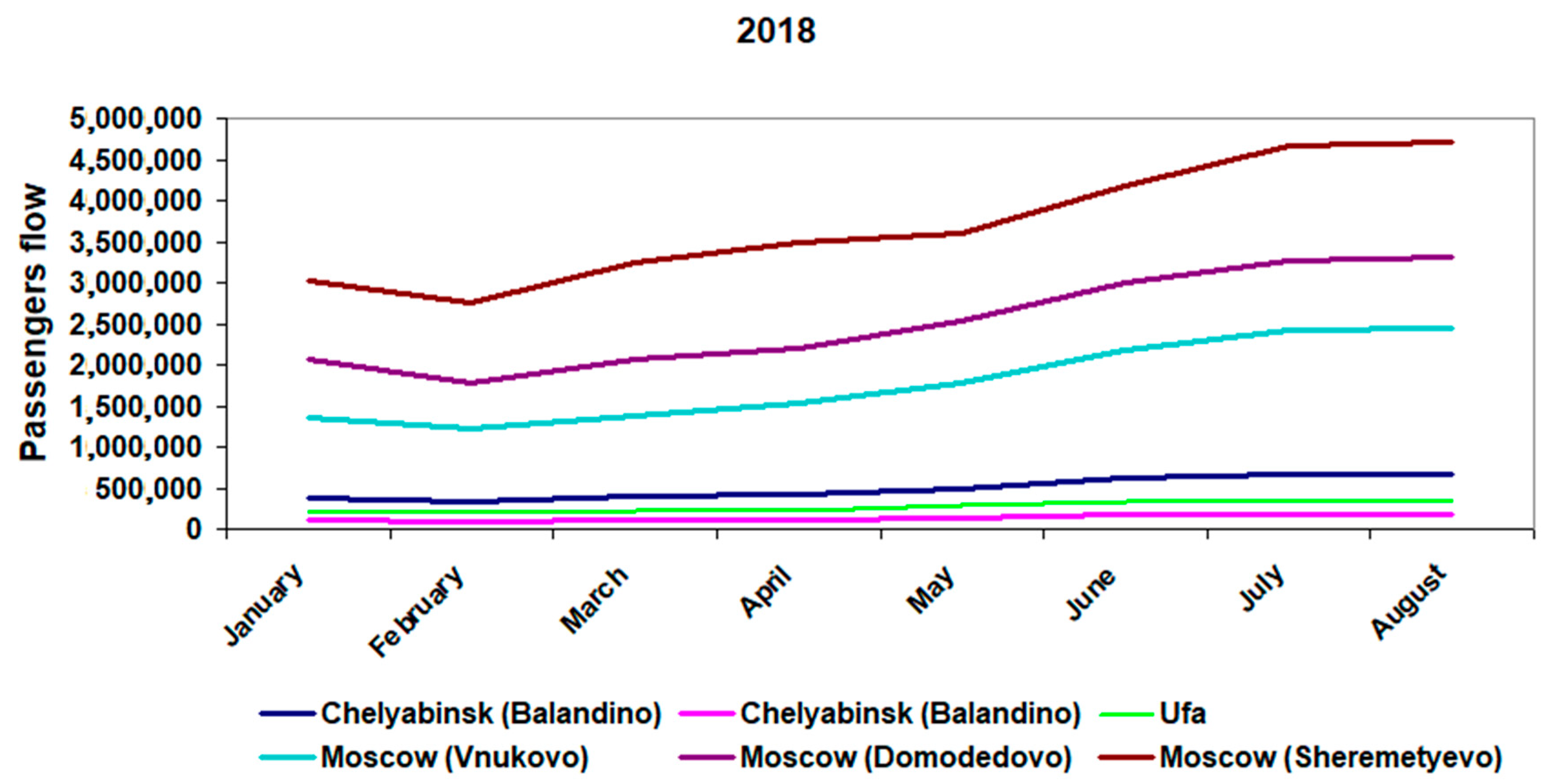
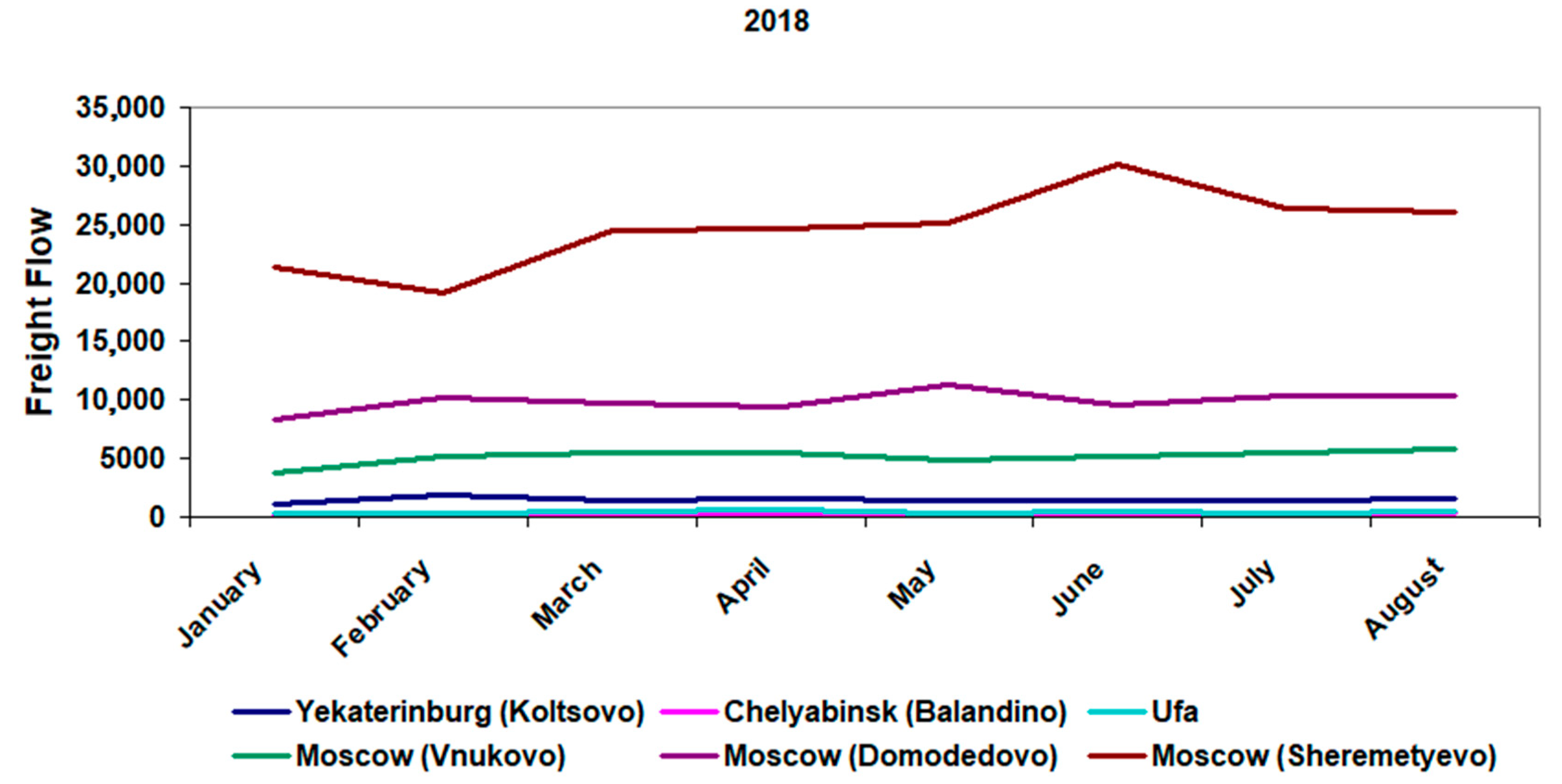

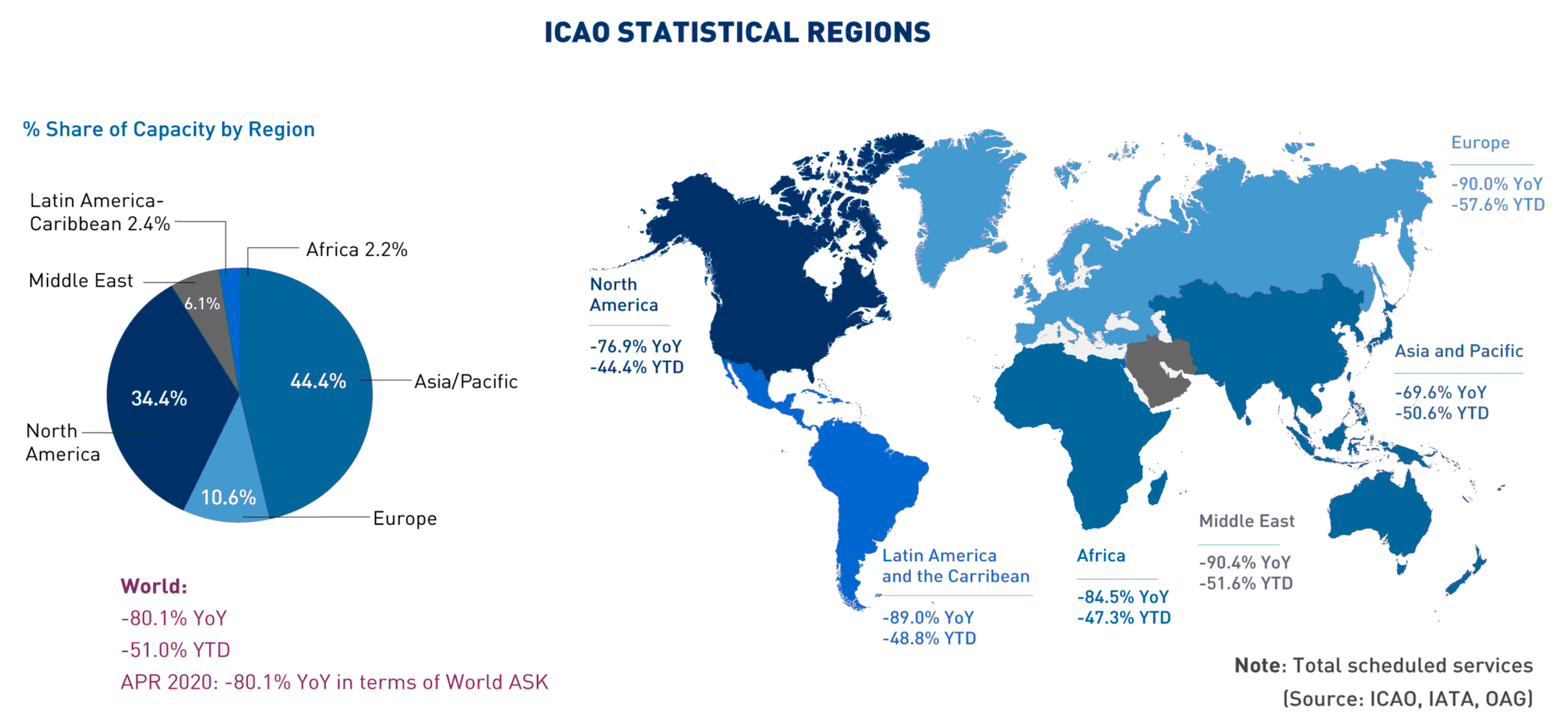
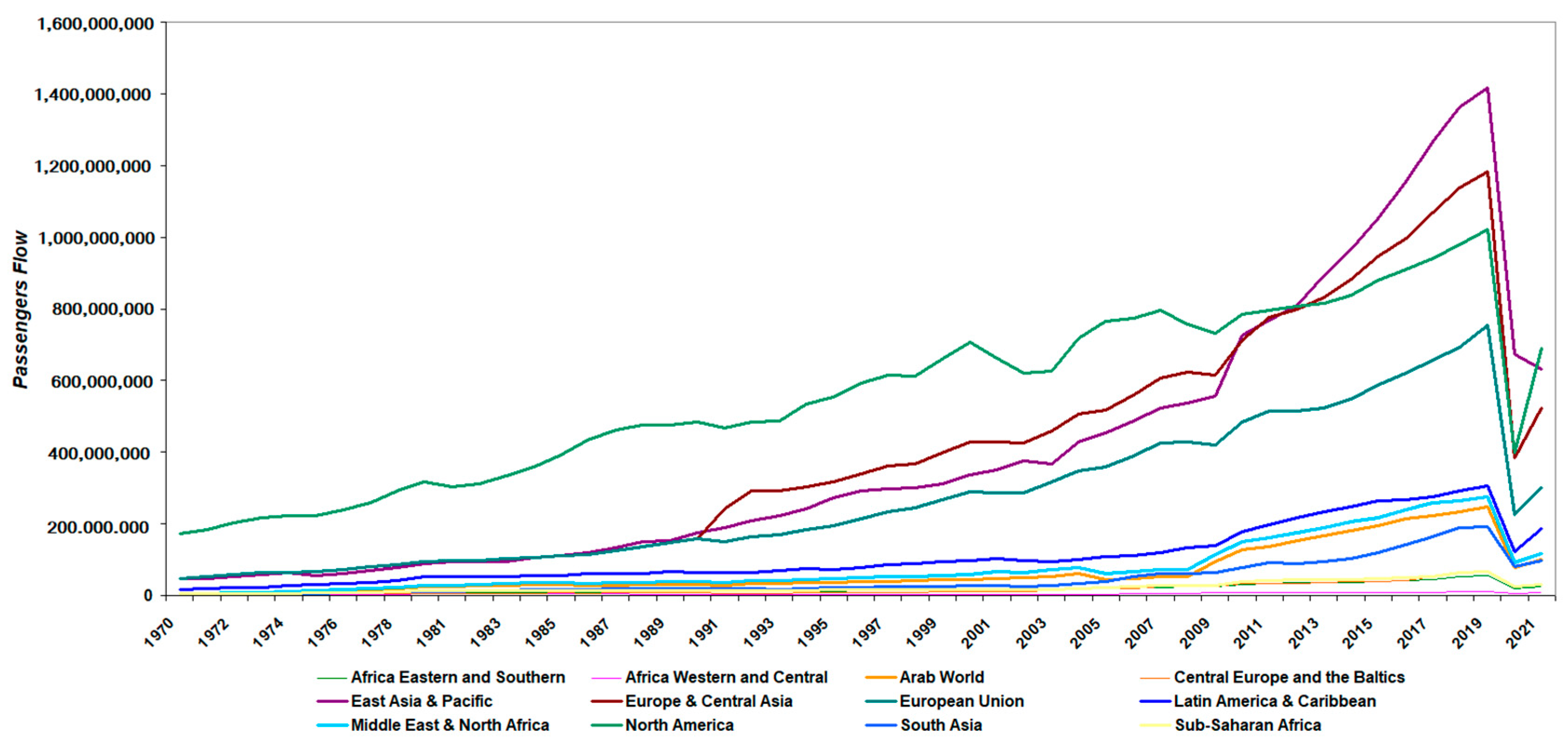

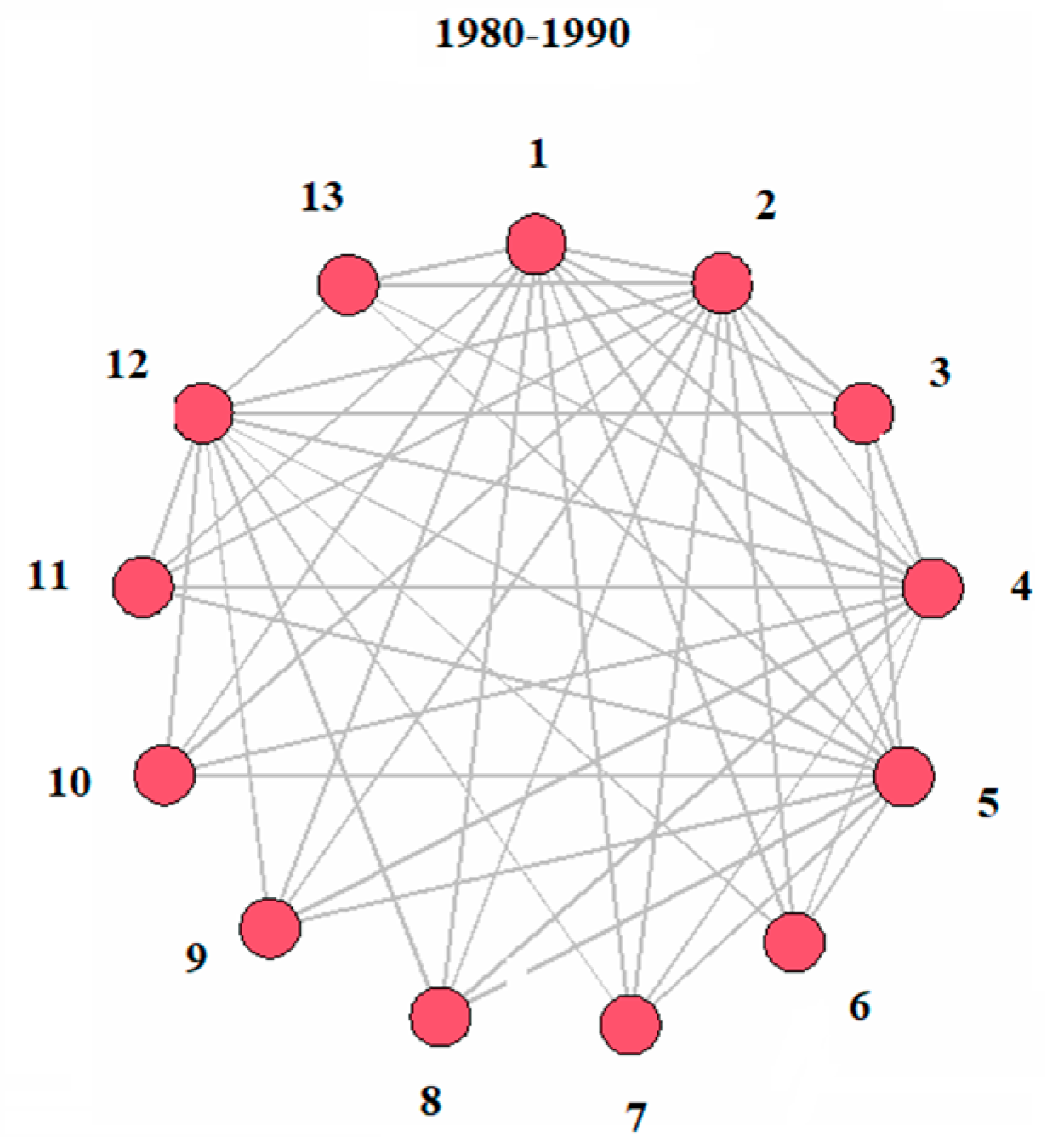

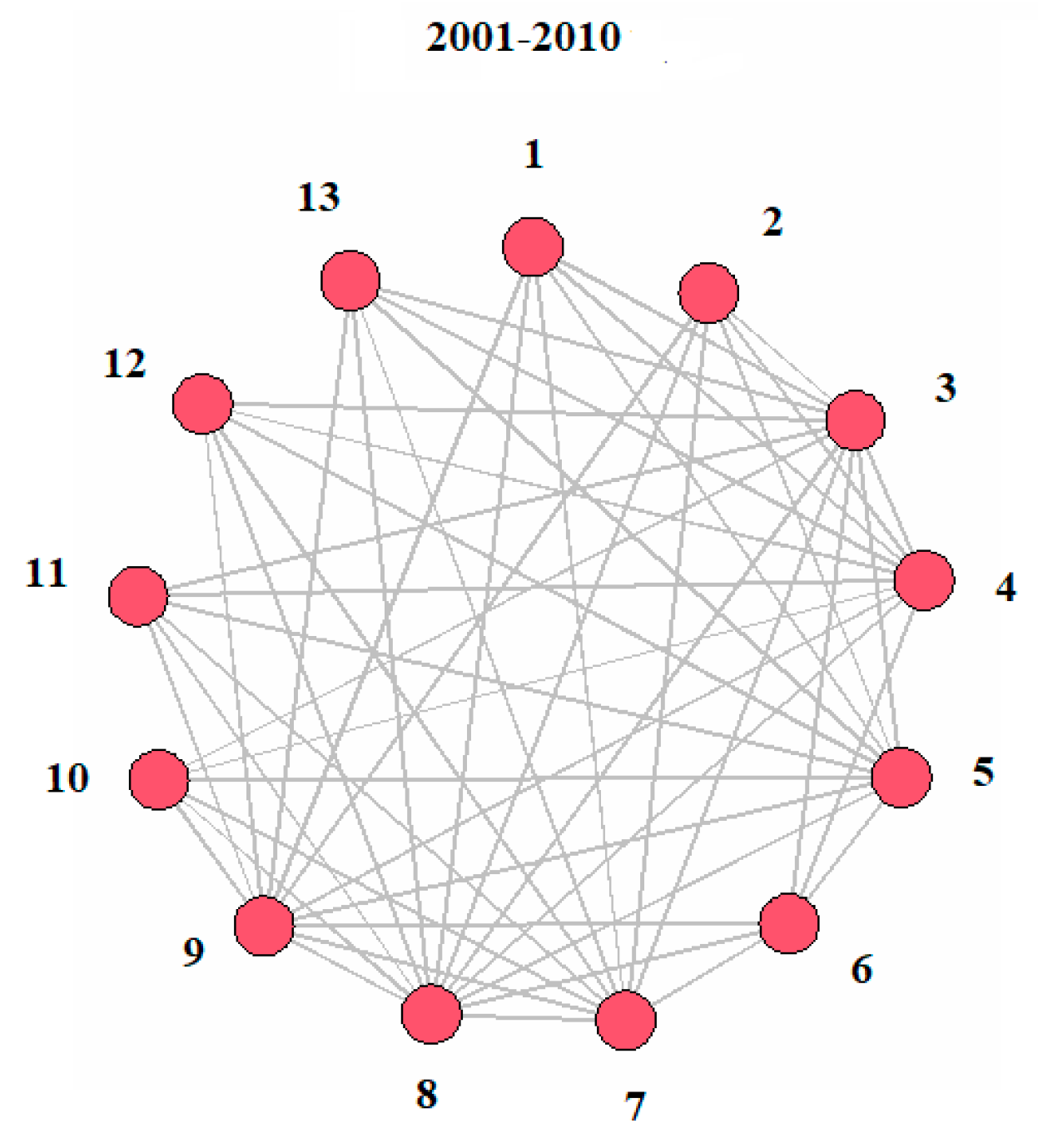
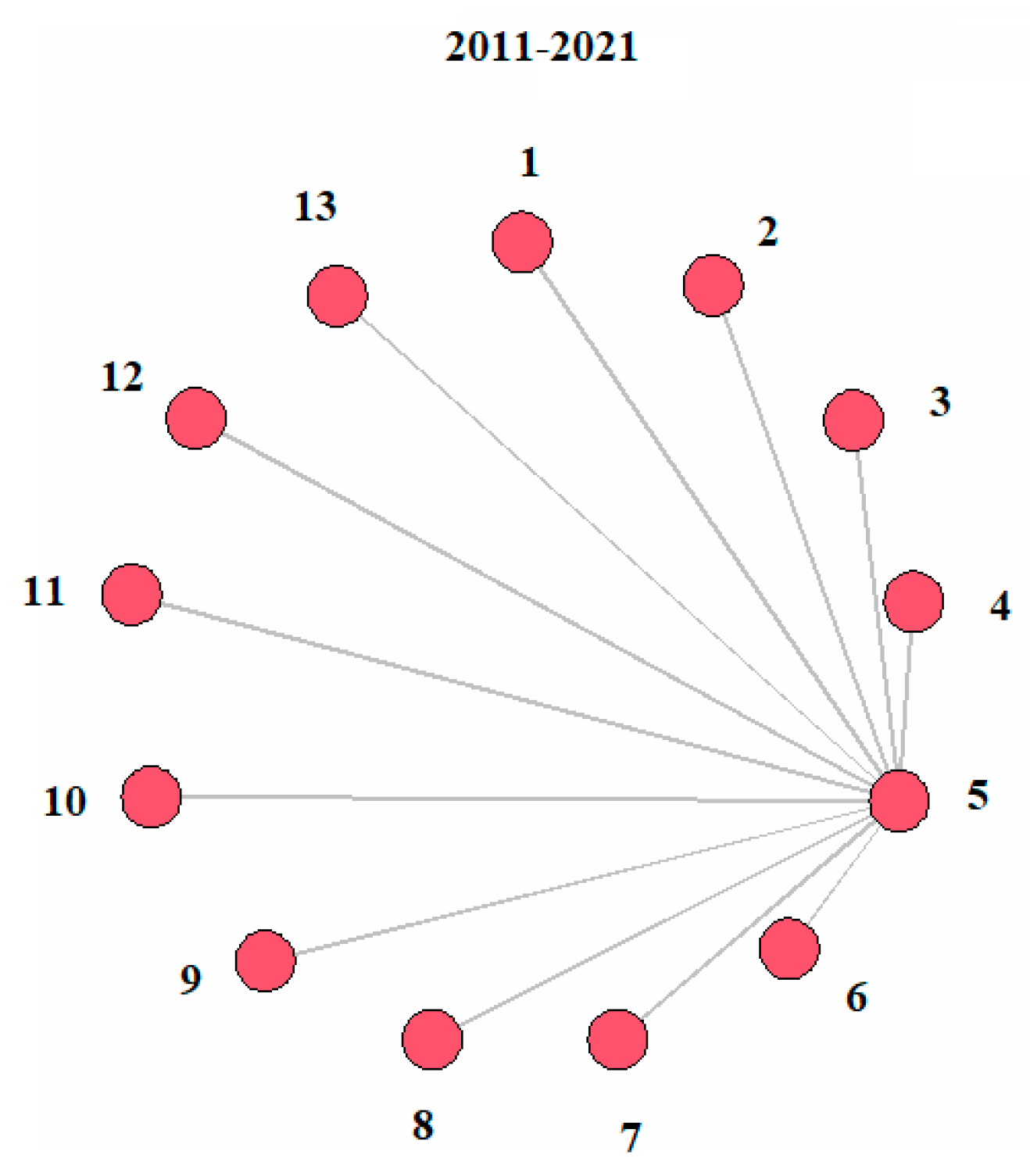
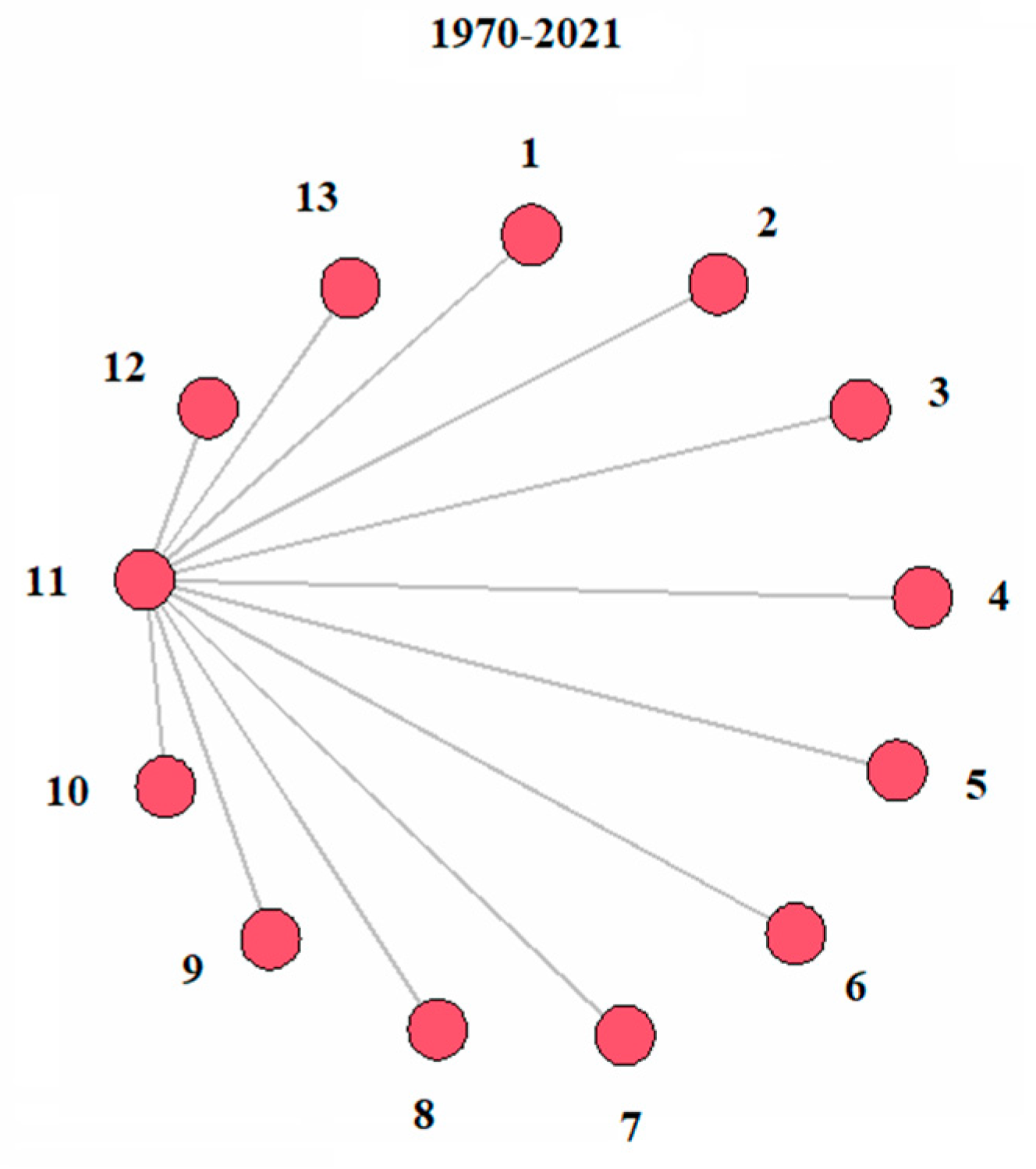
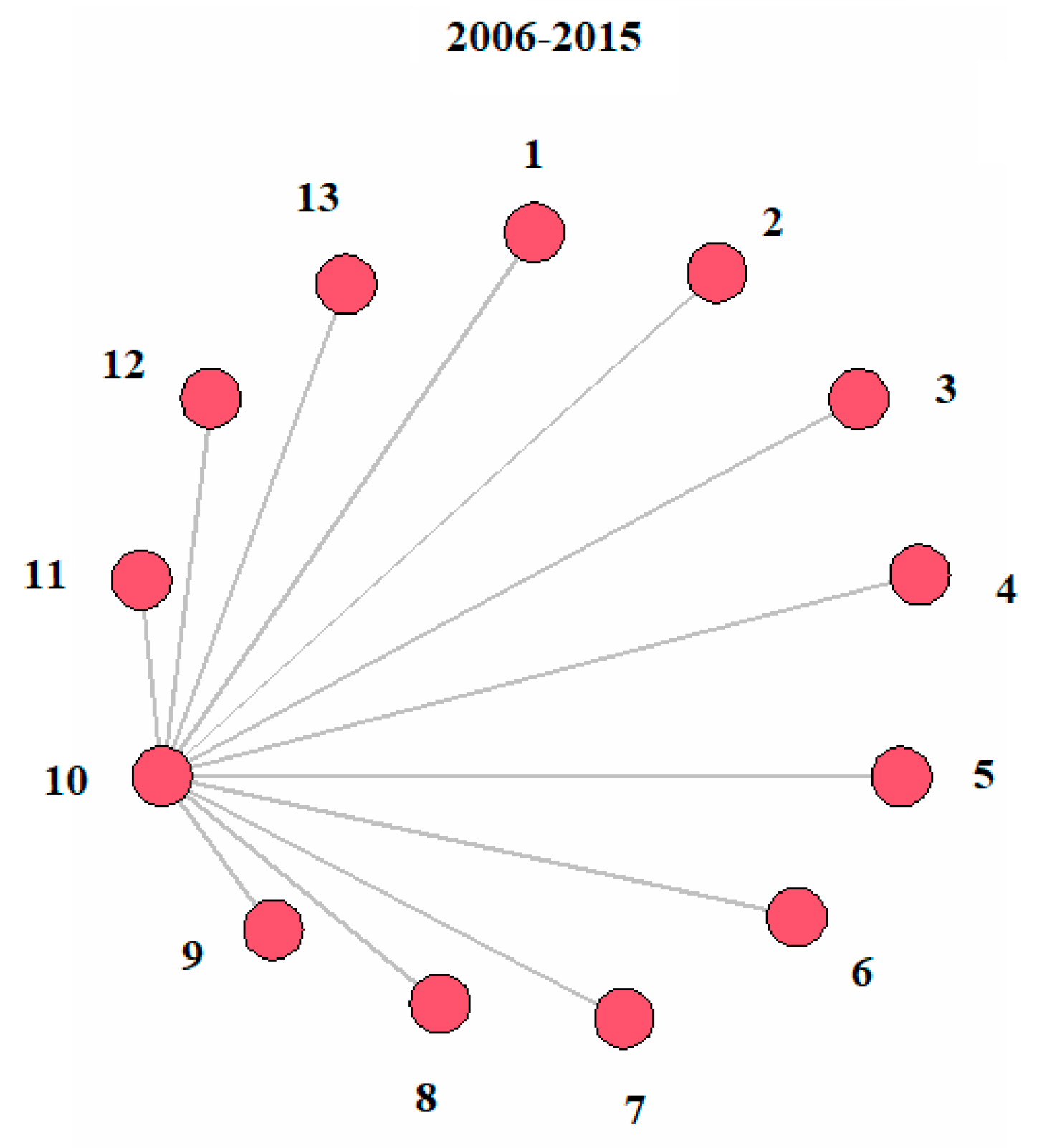

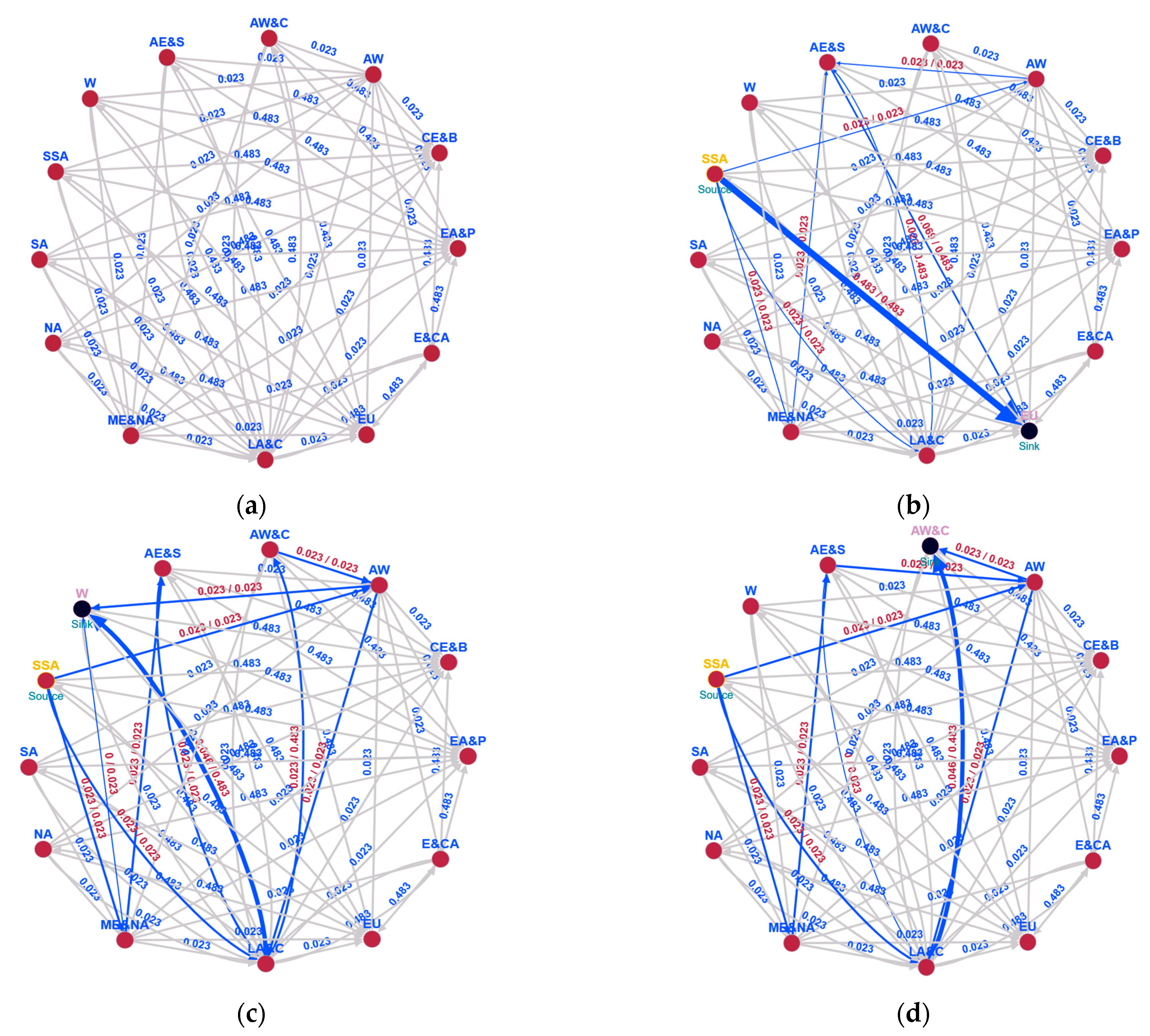
| Y | X | |||
|---|---|---|---|---|
| Total Movements | Air transport Movements | Terminal Passengers | Freight Tonnes | |
| Total movements | 0 | 0.13 | 0 | 0.13 |
| Air transport movements | 0.25 | 0 | 0 | 0.13 |
| Terminal passengers | 0 | 0.13 | 0 | 0 |
| Freight tonnes | 0 | 0 | 0 | 0 |
| Y | X | |||||
|---|---|---|---|---|---|---|
| Yekaterinburg | Chelyabinsk | Ufa | Moscow (Vnukovo) | Moscow (Domodedovo) | Moscow (Sheremetyevo) | |
| Yekaterinburg | 0 | 0 | 0.4/0 | 0 | 0 | 0 |
| Chelyabinsk | 0 | 0 | 0.1/0 | 0 | 0 | 0 |
| Ufa | 0/0.2 | 0/0.3 | 0 | 0.3/0.53 | 0.3/0.56 | 0.5/0.2 |
| Moscow (Vnukovo) | 0 | 0 | 0 | 0 | 0 | 0 |
| Moscow (Domodedovo) | 0 | 0 | 0 | 0 | 0 | 0 |
| Moscow (Sheremetyevo) | 0 | 0 | 0 | 0 | 0 | 0 |
| 1970–1921 | 1 | 2 | 3 | 4 | 5 | 6 | 7 | 8 | 9 | 10 | 11 | 12 | 13 |
|---|---|---|---|---|---|---|---|---|---|---|---|---|---|
| Africa Eastern and Southern | Africa Western and Central | Arab World | Central Europe and the Baltics | East Asia and Pacific | Europe and Central Asia | European Union | Latin America and Caribbean | Middle East and North Africa | North America | South Asia | Sub-Saharan Africa | World | |
| Africa Eastern and Southern | 0 | 0 | 0 | 0 | 0 | 0 | 0 | 0 | 0 | 0 | 0.18 | 0 | 0 |
| Africa Western and Central | 0 | 0 | 0 | 0 | 0 | 0 | 0 | 0 | 0 | 0 | 0.18 | 0 | 0 |
| Arab World | 0 | 0 | 0 | 0 | 0 | 0 | 0 | 0 | 0 | 0 | 0.18 | 0 | 0 |
| Central Europe and the Baltics | 0 | 0 | 0 | 0 | 0 | 0 | 0 | 0 | 0 | 0 | 0.18 | 0 | 0 |
| East Asia and Pacific | 0 | 0 | 0 | 0 | 0 | 0 | 0 | 0 | 0 | 0 | 0.18 | 0 | 0 |
| Europe and Central Asia | 0 | 0 | 0 | 0 | 0 | 0 | 0 | 0 | 0 | 0 | 0.18 | 0 | 0 |
| European Union | 0 | 0 | 0 | 0 | 0 | 0 | 0 | 0 | 0 | 0 | 0.18 | 0 | 0 |
| Latin America and Caribbean | 0 | 0 | 0 | 0 | 0 | 0 | 0 | 0 | 0 | 0 | 0.18 | 0 | 0 |
| Middle East and North Africa | 0 | 0 | 0 | 0 | 0 | 0 | 0 | 0 | 0 | 0 | 0.18 | 0 | 0 |
| North America | 0 | 0 | 0 | 0 | 0 | 0 | 0 | 0 | 0 | 0 | 0.18 | 0 | 0 |
| South Asia | 0.04 | 0.04 | 0.04 | 0.04 | 0 | 0.04 | 0 | 0.04 | 0.04 | 0.04 | 0 | 0.04 | 0 |
| Sub-Saharan Africa | 0 | 0 | 0 | 0 | 0 | 0 | 0 | 0 | 0 | 0 | 0.18 | 0 | 0 |
| World | 0 | 0 | 0 | 0 | 0 | 0 | 0 | 0 | 0 | 0 | 0.18 | 0 | 0 |
| 1970–1980 | 1 | 2 | 3 | 4 | 5 | 6 | 7 | 8 | 9 | 10 | 11 | 12 | 13 |
|---|---|---|---|---|---|---|---|---|---|---|---|---|---|
| Africa Eastern and Southern | Africa Western and Central | Arab World | Central Europe and the Baltics | East Asia and Pacific | Europe and Central Asia | European Union | Latin America and Caribbean | Middle East and North Africa | North America | South Asia | Sub-Saharan Africa | World | |
| Africa Eastern and Southern | 0 | 0 | 0 | 0 | 0.2 | 0 | 0 | 0 | 0 | 0 | 0.45 | 0 | 0 |
| Africa Western and Central | 0 | 0 | 0 | 0 | 0.2 | 0 | 0 | 0 | 0 | 0 | 0.45 | 0 | 0 |
| Arab World | 0 | 0 | 0 | 0 | 0.2 | 0 | 0 | 0 | 0 | 0 | 0.45 | 0 | 0 |
| Central Europe and the Baltics | 0 | 0 | 0 | 0 | 0.2 | 0 | 0 | 0 | 0 | 0 | 0.45 | 0 | 0 |
| East Asia and Pacific | 0 | 0 | 0 | 0 | 0 | 0 | 0 | 0 | 0 | 0 | 0.45 | 0 | 0 |
| Europe and Central Asia | 0 | 0 | 0 | 0 | 0.2 | 0 | 0 | 0 | 0 | 0 | 0.45 | 0 | 0 |
| European Union | 0 | 0 | 0 | 0 | 0.2 | 0 | 0 | 0 | 0 | 0 | 0.45 | 0 | 0 |
| Latin America and Caribbean | 0 | 0 | 0 | 0 | 0.2 | 0 | 0 | 0 | 0 | 0 | 0.45 | 0 | 0 |
| Middle East and North Africa | 0 | 0 | 0 | 0 | 0.2 | 0 | 0 | 0 | 0 | 0 | 0.45 | 0 | 0 |
| North America | 0 | 0 | 0 | 0 | 0.2 | 0 | 0 | 0 | 0 | 0 | 0.45 | 0 | 0 |
| South Asia | 0 | 0 | 0 | 0 | 0.2 | 0 | 0 | 0 | 0 | 0 | 0 | 0 | 0 |
| Sub-Saharan Africa | 0 | 0 | 0 | 0 | 0.2 | 0 | 0 | 0 | 0 | 0 | 0.45 | 0 | 0 |
| World | 0 | 0 | 0 | 0 | 0.2 | 0 | 0 | 0 | 0 | 0 | 0.45 | 0 | 0 |
| 1981–1990 | 1 | 2 | 3 | 4 | 5 | 6 | 7 | 8 | 9 | 10 | 11 | 12 | 13 |
|---|---|---|---|---|---|---|---|---|---|---|---|---|---|
| Africa Eastern and Southern | Africa Western and Central | Arab World | Central Europe and the Baltics | East Asia and Pacific | Europe and Central Asia | European Union | Latin America and Caribbean | Middle East and North Africa | North America | South Asia | Sub-Saharan Africa | World | |
| Africa Eastern and Southern | 0 | 0.02 | 0 | 0.02 | 0 | 0 | 0 | 0 | 0 | 0 | 0 | 0 | 0 |
| Africa Western and Central | 0 | 0 | 0 | 0 | 0 | 0 | 0 | 0 | 0 | 0 | 0 | 0 | 0 |
| Arab World | 0.23 | 0.02 | 0 | 0.48 | 0.5 | 0 | 0 | 0 | 0 | 0 | 0 | 0.023 | 0 |
| Central Europe and the Baltics | 0.23 | 0.02 | 0 | 0 | 0 | 0 | 0 | 0 | 0 | 0 | 0 | 0.023 | 0 |
| East Asia and Pacific | 0.23 | 0.02 | 0 | 0 | 0 | 0 | 0 | 0 | 0 | 0 | 0 | 0.023 | 0 |
| Europe and Central Asia | 0.23 | 0.02 | 0 | 0.48 | 0.5 | 0 | 0 | 0 | 0 | 0 | 0 | 0.023 | 0 |
| European Union | 0.23 | 0.02 | 0 | 0.48 | 0.5 | 0 | 0 | 0 | 0 | 0 | 0 | 0.023 | 0 |
| Latin America and Caribbean | 0.23 | 0.02 | 0 | 0.48 | 0.5 | 0 | 0 | 0 | 0 | 0 | 0 | 0.023 | 0 |
| Middle East and North Africa | 0.23 | 0.02 | 0 | 0.48 | 0.5 | 0 | 0 | 0 | 0 | 0 | 0 | 0.023 | 0 |
| North America | 0.23 | 0.02 | 0 | 0.48 | 0.5 | 0 | 0 | 0 | 0 | 0 | 0 | 0.023 | 0 |
| South Asia | 0.23 | 0.02 | 0 | 0.48 | 0.5 | 0 | 0 | 0 | 0 | 0 | 0 | 0.023 | 0 |
| Sub-Saharan Africa | 0 | 0.02 | 0 | 0.48 | 0 | 0 | 0 | 0 | 0 | 0 | 0 | 0 | 0 |
| World | 0.23 | 0.02 | 0 | 0.48 | 0.5 | 0 | 0 | 0 | 0 | 0 | 0 | 0.023 | 0 |
| 1991–2000 | 1 | 2 | 3 | 4 | 5 | 6 | 7 | 8 | 9 | 10 | 11 | 12 | 13 |
|---|---|---|---|---|---|---|---|---|---|---|---|---|---|
| Africa Eastern and Southern | Africa Western and Central | Arab World | Central Europe and the Baltics | East Asia and Pacific | Europe and Central Asia | European Union | Latin America and Caribbean | Middle East and North Africa | North America | South Asia | Sub-Saharan Africa | World | |
| Africa Eastern and Southern | 0 | 0.48 | 0 | 0 | 0 | 0 | 0 | 0 | 0 | 0 | 0.483 | 0 | 0 |
| Africa Western and Central | 0.02 | 0 | 0 | 0 | 0 | 0 | 0 | 0 | 0 | 0 | 0.023 | 0.023 | 0 |
| Arab World | 0.48 | 0.02 | 0 | 0 | 0 | 0 | 0 | 0 | 0 | 0 | 0.023 | 0.483 | 0 |
| Central Europe and the Baltics | 0.48 | 0.02 | 0 | 0 | 0 | 0 | 0 | 0 | 0 | 0 | 0.023 | 0.483 | 0 |
| East Asia and Pacific | 0.48 | 0.02 | 0 | 0 | 0 | 0 | 0 | 0 | 0 | 0 | 0.023 | 0.483 | 0 |
| Europe and Central Asia | 0.48 | 0.02 | 0 | 0 | 0 | 0 | 0 | 0 | 0 | 0 | 0.023 | 0.483 | 0 |
| European Union | 0.48 | 0.02 | 0 | 0 | 0 | 0 | 0 | 0 | 0 | 0 | 0.023 | 0.483 | 0 |
| Latin America and Caribbean | 0.48 | 0.02 | 0 | 0 | 0 | 0 | 0 | 0 | 0 | 0 | 0.023 | 0.483 | 0 |
| Middle East and North Africa | 0.48 | 0.02 | 0 | 0 | 0 | 0 | 0 | 0 | 0 | 0 | 0.023 | 0.483 | 0 |
| North America | 0.48 | 0.02 | 0 | 0 | 0 | 0 | 0 | 0 | 0 | 0 | 0.023 | 0.483 | 0 |
| South Asia | 0.02 | 0 | 0 | 0 | 0 | 0 | 0 | 0 | 0 | 0 | 0 | 0.023 | 0 |
| Sub-Saharan Africa | 0 | 0.48 | 0 | 0 | 0 | 0 | 0 | 0 | 0 | 0 | 0.483 | 0 | 0 |
| World | 0.48 | 0.02 | 0 | 0 | 0 | 0 | 0 | 0 | 0 | 0 | 0.023 | 0.483 | 0 |
| 2001–2010 | 1 | 2 | 3 | 4 | 5 | 6 | 7 | 8 | 9 | 10 | 11 | 12 | 13 |
|---|---|---|---|---|---|---|---|---|---|---|---|---|---|
| Africa Eastern and Southern | Africa Western and Central | Arab World | Central Europe and the Baltics | East Asia and Pacific | Europe and Central Asia | European Union | Latin America and Caribbean | Middle East and North Africa | North America | South Asia | Sub-Saharan Africa | World | |
| Africa Eastern and Southern | 0 | 0 | 0.02 | 0 | 0 | 0 | 0 | 0.48 | 0.02 | 0 | 0 | 0 | 0 |
| Africa Western and Central | 0 | 0 | 0.02 | 0 | 0 | 0 | 0 | 0.48 | 0.02 | 0 | 0 | 0 | 0 |
| Arab World | 0.02 | 0.02 | 0 | 0 | 0 | 0.02 | 0 | 0.02 | 0 | 0.02 | 0.023 | 0.023 | 0 |
| Central Europe and the Baltics | 0.48 | 0.48 | 0.02 | 0 | 0 | 0.48 | 0 | 0.02 | 0.02 | 0.48 | 0.483 | 0.483 | 0.5 |
| East Asia and Pacific | 0.48 | 0.48 | 0.02 | 0 | 0 | 0.48 | 0 | 0.02 | 0.02 | 0.48 | 0.483 | 0.483 | 0.5 |
| Europe and Central Asia | 0 | 0 | 0.02 | 0 | 0 | 0 | 0 | 0.48 | 0.02 | 0 | 0 | 0 | 0 |
| European Union | 0.48 | 0.48 | 0.02 | 0 | 0 | 0.48 | 0 | 0.02 | 0.02 | 0.48 | 0.483 | 0.483 | 0.5 |
| Latin America and Caribbean | 0.02 | 0.02 | 0.02 | 0 | 0 | 0.02 | 0 | 0 | 0.02 | 0.02 | 0.023 | 0.023 | 0 |
| Middle East and North Africa | 0.02 | 0.02 | 0 | 0 | 0 | 0.02 | 0 | 0.02 | 0 | 0.02 | 0.023 | 0.023 | 0 |
| North America | 0 | 0 | 0.02 | 0 | 0 | 0 | 0 | 0.48 | 0.02 | 0 | 0 | 0 | 0 |
| South Asia | 0 | 0 | 0.02 | 0 | 0 | 0 | 0 | 0.48 | 0.02 | 0 | 0 | 0 | 0 |
| Sub-Saharan Africa | 0 | 0 | 0.02 | 0 | 0 | 0 | 0 | 0.48 | 0.02 | 0 | 0 | 0 | 0 |
| World | 0 | 0 | 0.02 | 0 | 0 | 0 | 0 | 0.48 | 0.02 | 0 | 0 | 0 | 0 |
| 2011–2021 | 1 | 2 | 3 | 4 | 5 | 6 | 7 | 8 | 9 | 10 | 11 | 12 | 13 |
|---|---|---|---|---|---|---|---|---|---|---|---|---|---|
| Africa Eastern and Southern | Africa Western and Central | Arab World | Central Europe and the Baltics | East Asia and Pacific | Europe and Central Asia | European Union | Latin America and Caribbean | Middle East and North Africa | North America | South Asia | Sub-Saharan Africa | World | |
| Africa Eastern and Southern | 0 | 0 | 0 | 0 | 0.5 | 0 | 0 | 0 | 0 | 0 | 0 | 0 | 0 |
| Africa Western and Central | 0 | 0 | 0 | 0 | 0.5 | 0 | 0 | 0 | 0 | 0 | 0 | 0 | 0 |
| Arab World | 0 | 0 | 0 | 0 | 0.5 | 0 | 0 | 0 | 0 | 0 | 0 | 0 | 0 |
| Central Europe and the Baltics | 0 | 0 | 0 | 0 | 0.5 | 0 | 0 | 0 | 0 | 0 | 0 | 0 | 0 |
| East Asia and Pacific | 0 | 0 | 0 | 0 | 0 | 0 | 0 | 0 | 0 | 0 | 0 | 0 | 0 |
| Europe and Central Asia | 0 | 0 | 0 | 0 | 0.5 | 0 | 0 | 0 | 0 | 0 | 0 | 0 | 0 |
| European Union | 0 | 0 | 0 | 0 | 0.5 | 0 | 0 | 0 | 0 | 0 | 0 | 0 | 0 |
| Latin America and Caribbean | 0 | 0 | 0 | 0 | 0.5 | 0 | 0 | 0 | 0 | 0 | 0 | 0 | 0 |
| Middle East and North Africa | 0 | 0 | 0 | 0 | 0.5 | 0 | 0 | 0 | 0 | 0 | 0 | 0 | 0 |
| North America | 0 | 0 | 0 | 0 | 0.5 | 0 | 0 | 0 | 0 | 0 | 0 | 0 | 0 |
| South Asia | 0 | 0 | 0 | 0 | 0.5 | 0 | 0 | 0 | 0 | 0 | 0 | 0 | 0 |
| Sub-Saharan Africa | 0 | 0 | 0 | 0 | 0.5 | 0 | 0 | 0 | 0 | 0 | 0 | 0 | 0 |
| World | 0 | 0 | 0 | 0 | 0.5 | 0 | 0 | 0 | 0 | 0 | 0 | 0 | 0 |
| 2005–2016 | 1 | 2 | 3 | 4 | 5 | 6 | 7 | 8 | 9 | 10 | 11 | 12 | 13 |
|---|---|---|---|---|---|---|---|---|---|---|---|---|---|
| Africa Eastern and Southern | Africa Western and Central | Arab World | Central Europe and the Baltics | East Asia and Pacific | Europe and Central Asia | European Union | Latin America and Caribbean | Middle East and North Africa | North America | South Asia | Sub-Saharan Africa | World | |
| Africa Eastern and Southern | 0 | 0 | 0 | 0 | 0 | 0 | 0 | 0 | 0 | 0.02 | 0 | 0 | 0 |
| Africa Western and Central | 0 | 0 | 0 | 0 | 0 | 0 | 0 | 0 | 0 | 0.02 | 0 | 0 | 0 |
| Arab World | 0 | 0 | 0 | 0 | 0 | 0 | 0 | 0 | 0 | 0.02 | 0 | 0 | 0 |
| Central Europe and the Baltics | 0 | 0 | 0 | 0 | 0 | 0 | 0 | 0 | 0 | 0.02 | 0 | 0 | 0 |
| East Asia and Pacific | 0 | 0 | 0 | 0 | 0 | 0 | 0 | 0 | 0 | 0.02 | 0 | 0 | 0 |
| Europe and Central Asia | 0 | 0 | 0 | 0 | 0 | 0 | 0 | 0 | 0 | 0.02 | 0 | 0 | 0 |
| European Union | 0 | 0 | 0 | 0 | 0 | 0 | 0 | 0 | 0 | 0.02 | 0 | 0 | 0 |
| Latin America and Caribbean | 0 | 0 | 0 | 0 | 0 | 0 | 0 | 0 | 0 | 0.02 | 0 | 0 | 0 |
| Middle East and North Africa | 0 | 0 | 0 | 0 | 0 | 0 | 0 | 0 | 0 | 0.02 | 0 | 0 | 0 |
| North America | 0 | 0 | 0 | 0 | 0 | 0 | 0 | 0 | 0 | 0 | 0 | 0 | 0 |
| South Asia | 0 | 0 | 0 | 0 | 0 | 0 | 0 | 0 | 0 | 0.02 | 0 | 0 | 0 |
| Sub-Saharan Africa | 0 | 0 | 0 | 0 | 0 | 0 | 0 | 0 | 0 | 0.02 | 0 | 0 | 0 |
| World | 0 | 0 | 0 | 0 | 0 | 0 | 0 | 0 | 0 | 0.02 | 0 | 0 | 0 |
Disclaimer/Publisher’s Note: The statements, opinions and data contained in all publications are solely those of the individual author(s) and contributor(s) and not of MDPI and/or the editor(s). MDPI and/or the editor(s) disclaim responsibility for any injury to people or property resulting from any ideas, methods, instructions or products referred to in the content. |
© 2024 by the authors. Licensee MDPI, Basel, Switzerland. This article is an open access article distributed under the terms and conditions of the Creative Commons Attribution (CC BY) license (https://creativecommons.org/licenses/by/4.0/).
Share and Cite
Valeev, S.; Kondratyeva, N. The Air Transportation System as a Subsystem of Modern Communication Space: Analysis Based on Transfer Entropy Graphs. Appl. Sci. 2024, 14, 11291. https://doi.org/10.3390/app142311291
Valeev S, Kondratyeva N. The Air Transportation System as a Subsystem of Modern Communication Space: Analysis Based on Transfer Entropy Graphs. Applied Sciences. 2024; 14(23):11291. https://doi.org/10.3390/app142311291
Chicago/Turabian StyleValeev, Sagit, and Natalya Kondratyeva. 2024. "The Air Transportation System as a Subsystem of Modern Communication Space: Analysis Based on Transfer Entropy Graphs" Applied Sciences 14, no. 23: 11291. https://doi.org/10.3390/app142311291
APA StyleValeev, S., & Kondratyeva, N. (2024). The Air Transportation System as a Subsystem of Modern Communication Space: Analysis Based on Transfer Entropy Graphs. Applied Sciences, 14(23), 11291. https://doi.org/10.3390/app142311291






